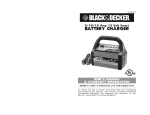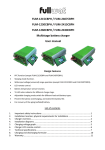Download Charging System Activity 8 Battery Diagnosis and Testing Charging
Transcript
Charging System 812FJ Student Manual Charging System Activity 8 Battery Diagnosis and Testing Performance Objectives: • Perform a battery inspection. • Perform a battery state of charge test. • Perform a battery load test. • Perform a 3-minute Charge Test. (Optional). Tools and Materials: • 12-Volt Battery • Starting and Charging Tester with inductive ammeter and carbon-pile load (VAT 40 or equivalent) • Digital Multi-Meter • Battery Charger (capable of 40 Amps minimum) • Safety Goggles References: • Ford Starting and Charging System Diagnosis Reference Book • 2003 Chevrolet Impala Service Manual Information Charging System – Activity 8 8-1 Reference Book: • Read pages 3-1 to 3-14 in the Reference Book. Review Questions: • Answer the Review Questions on pages 3-15 and 3-16. Do not write in the Reference Book. Use a separate piece of paper to record your answers. (Answers are provided on page 3-18). Note: The Battery Drain Test With Volt-Ohmmeter, To Test Vehicles With Major Key-Off Loads, and To Check for Electronic Drains tests listed on pages 3-8 through 3-10 and the Test Lamp test referenced on Page 3-3 of the Ford Starting and Charging System Diagnosis Reference Book will not give accurate results on modern vehicles. GM has a procedure called the Battery Electrical Drain/Parasitic Load Test that will be a more accurate method of measuring parasitic load or battery drain on multi-computer and module-equipped vehicles. This GM procedure can be found on page 29 of the 2003 Chevrolet Impala Service Manual Information provided with this courseware. For best accuracy and results, follow the manufacturer’s published Service Manual procedures for checking electrical drains. Battery Drain Testing will be discussed in Activity 11 of this course. Battery Testing: Both the starting system and charging systems depend on a good battery for proper operation and best performance. Battery diagnosis begins with a thorough visual inspection. As noted on Page 3-2 of the Reference Book, malfunctions can often be determined by closely observing the battery’s physical condition. Any identified problems must be corrected before proceeding with electrical tests. Attempting to charge or load test a physically damaged battery can cause an explosion! 1. Before testing, a battery should be visually inspected for: a. Case cracks or buckling b. Cable, connection, and terminal security and corrosion c. Expected service life via the manufacturing date code d. All of these Batteries can be electrically tested two ways: • Many vehicle manufacturers now specify that an electronic battery tester be used. Electronic testers typically measure battery conductance, which is a passive indicator of battery condition. One advantage to this method is that the battery can be accurately tested even if it is in a discharged condition. The electronic battery tester is now a required GM dealer service tool. The GM Service Manual procedure for using this tool is called Battery Inspection/Test, and it can be found on page 20 of the 2003 Chevrolet Impala Service Manual Information provided with this courseware. Charging System – Activity 8 8-2 • A traditional load tester (similar to the Sun VAT 40 or equivalent) can also be used, but the battery must be fully charged prior to being tested in order for the results to be accurate. To properly perform this test, you need to understand battery capacity rating and how to determine the battery’s state of charge. Load Testing: A Load Test measures battery voltage by applying a load equal to one half of the battery’s CCA rating for 15 seconds. With the battery at room temperature, its voltage reading must not fall below 9.6 volts while this load is being applied. The battery must have at least a 75% state of charge before performing this test. The battery’s State of Charge can be determined by performing an Open Circuit Voltage (OCV) test using a DMM as described on Page 3-5 of the Reference Book. Note: Step 2 of this test states to disconnect the negative battery cable when OCV testing a battery that is still installed in a vehicle. This is no longer recommended. In-vehicle OCV tests can safely be performed with both battery cables connected. 2. According to Page 3-5 of the Reference Book, a battery at or near full charge should have an OCV reading of: a. 12.60V or above b. 12.50V or above c. 12.40V or above d. 12.30V or above Low Maintenance or filler-cap type batteries can be State of Charge tested using a hydrometer as described on Pages 3-8 and 3-9 of the Reference Book. 3. According to Page 3-9 of the Reference Book, a battery at or near full charge should have a hydrometer reading of: a. 1.165 b. 1.200 c. 1.235 d. 1.265 Note: The State of Charge Test does not measure a battery’s storage capacity or its current production (Amp-Hour) capacity. A Load Test is an active test. The carbon pile, which is the tester component that actually applies the load to the battery, produces heat. Sparks can be produced at the tester cable to battery connections if they are not clean and secure. Sparks can also occur inside the battery as a result of damaged internal connections. These can be dangerous around a previously charged battery where flammable hydrogen gas from the charging process may ignite and cause an explosion. Charging System – Activity 8 8-3 The Load Test Procedure is described on Page 3-10 of the Reference Book. Before load testing a battery, be sure to read all applicable operation documentation for your particular make and model of load tester. Also, when using any type of load tester, make certain that the load is turned completely off before connecting the tester to the battery to avoid the potential for creating a spark. 4. According to Page 3-10 of the Reference Book, if CCA information is not available for a particular battery it can be safely load tested by applying a load equal to: a. The Amp-Hour rating b. The Amp-Hour rating x 2 c. The Amp-Hour rating x 3 d. The Amp-Hour rating x 4 Conductance Testing: Conductance testers report the actual power available in the battery in relation to that battery’s CCA rating. The available power of a new battery will typically test 10–15% higher than its CCA rating. As the battery ages, available power in CCA will decrease. Batteries that conductance test at a figure below their original rating should be replaced. For example, a 700 CCA rated battery that tests at 525 CCA available power shows that the battery is not able to perform up to its rated capability of 700 CCA. Replacement would be recommended. CAUTION - If a conductance test indicates “bad cell” or “replace”, do not attempt to charge the battery. Charging a battery with one or more bad cells could cause an explosion! Follow the instructions provided with the conductance tester to insure accurate test results. Some AGM battery manufacturers specify adding 100 to the CCA rating entered into the conductance tester to properly evaluate remaining battery capacity. Conclusion: The State of Charge Test can be performed using a voltmeter or hydrometer depending on the type of battery (maintenance-free or low-maintenance). A reading of 12.4 volts (specific gravity 1.225) or above indicates a battery at least 75% charged. The Load Test requires a high rate discharge tester to be connected to the battery. The load should be set to 1/2 the Cold Cranking Amps (CCA) or 3 times the Amp-Hour rating (whichever is labeled on the battery). The load should be applied for 15 seconds and the voltage should not drop below 9.6 volts (at 70F) during this time. The Conductance Test should be performed by following the instructions provided with the conductance tester. Complete the In-Shop Worksheet at this time. Charging System – Activity 8 8-4 In-Shop Worksheet Activity 8 Battery Diagnosis and Testing Tools and Materials: • 12-Volt Battery • Starting and Charging Tester with inductive ammeter and carbon-pile load (VAT 40 or equivalent) • Digital Multi-Meter • Battery Charger (capable of 40 Amps minimum) • Ford Starting and Charging System Diagnosis Reference Book • Safety Goggles Important: Because of the materials used in the manufacture of automotive lead-acid batteries, dealers and service shops that handle them are subject to regulations issued by OSHA, EPA, DOT, and various state or local agencies. Other regulations may also apply in other locations. Always know and follow these regulations when servicing or handling batteries. Important: Wear safety goggles. Note: Always use caution when handling a battery since battery gases (hydrogen) are EXPLOSIVE and the acid can cause severe burns. Procedures: • Perform the Preliminary Inspection as shown on Page 3-2 of the Reference Book. The following questions will serve as a checklist. Inspection: 1. Has the battery exceeded its service life according to its date code? (an example would be a 36 month battery that is more than 36 months old according to the date code) a. Yes b. No 2. Is the battery case or top cover cracked or buckling? a. Yes b. No 3. Are there any other external signs of previous physical damage to the battery? a. Yes b. No If the answer to any of these first three questions is Yes, the battery should be replaced. Charging System – Activity 8 8-5 4. Do any of the battery terminals, cables and connectors or clamps appear to be loose or corroded? a. Yes b. No If the answer to question four is Yes, the observed condition must be corrected before any further testing is done. 5. Technician A says that if a battery terminal is loose in the battery itself, the battery should be replaced. Technician B says that loose connectors should be cleaned and tightened to manufacturer’s specs. Which Technician is correct? a. Technician A only b. Technician B only c. Both Technician A and Technician B are correct d. Neither Technician A nor Technician B is correct 6. Technician A says that battery cables that show signs of corrosion under the insulation or that have damaged insulation or terminals should be replaced. Technician B says that all corroded battery cable connectors can be cleaned and reused. Which Technician is correct? a. Technician A only b. Technician B only c. Both Technician A and Technician B are correct d. Neither Technician A nor Technician B is correct Battery Rating: 7. Are the CCA or Amp-Hour ratings printed and legible on the battery or label? a. Yes b. No • Make a note of the CCA or Amp-Hour rating for future reference. 8. Has the battery been in a running vehicle or on charge at any point in the last 24 hours? a. Yes b. No If the answer to question eight is Yes, the surface charge must be removed before an accurate OCV measurement can be made. Surface Charge Removal: • Using the Starting and Charging tester, apply a 30 amp load to the battery for about 10 seconds (or a 20 amp load for 1 minute) to remove the surface charge. Disconnect the tester when done. • If the battery is still installed in a vehicle, turn the high beam headlights on for 10 seconds to remove the surface charge. • Wait 2 minutes before proceeding to the OCV Test. Charging System – Activity 8 8-6 Battery State of Charge - Open Circuit Voltage Test: Note: All answers to questions with measured values are approximate. Choose the answer that is the closest to your actual measurement. 9. Using a DMM, measure and record the battery OCV at the terminals. What is the voltage reading? a. 12.6V b. 12.4V c. 12.2V d. None of these • Locate your measurement in the following chart: Open Circuit Voltage 12.6 12.4 12.2 12.0 11.9 State of Charge 100% 75% 50% 25% 0% 10. What is the approximate State of Charge of the battery? a. 25% or less b. 50% c. 75% d. 100% If the answer to question ten is A or B, the battery must be charged before load testing. Battery State of Charge - Hydrometer Test: Note: This test is for Low Maintenance or filler-cap type batteries only. Skip this test if you are working with a maintenance-free battery. • Perform the Hydrometer Test following steps 1-9 on Page 3-9 of the Reference Book. Note your readings here: Negative post Positive post Cell 1 Cell 2 Cell 3 Cell 4 Cell 5 Cell 6 ______ ______ ______ ______ ______ ______ Charging System – Activity 8 8-7 • Locate your measurements in the following chart: Specific Gravity 1.265 1.225 1.190 1.155 1.100 State of Charge 100% 75% 50% 25% 0% 11. Are all cells at a 75% or greater State of charge? a. Yes b. No If the answer to question eleven is No, battery must be charged before load testing. 12. Is the difference between the highest and lowest reading less than 50 points (.050)? a. Yes b. No If the answer to question eleven is Yes, and the answer to question twelve is No, the battery should be replaced. Load Test: • Verify that the battery is at least 75% charged. • Between Questions 7 and 8 of this worksheet, you were asked to make a note of the CCA or Amp-Hour rating of the battery you are testing for future reference. Use that rating to determine the proper load (Amps) for testing this battery: 1/2 x CCA ______ or 3 x Amp-Hours ______ • Using the Starting and Charging tester, apply the proper load to the battery for 15 seconds. Disconnect the tester when done. 13. Did the battery voltage read less than 9.6V under load? a. Yes b. No If the answer to question thirteen is Yes, the battery should be replaced. • Wait 2 minutes, then measure and record the battery OCV again. 14. What is the voltage reading? a. 12.6V b. 12.4V c. 12.2V d. None of these Charging System – Activity 8 8-8 3-Minute Charge Test (Optional): • If a battery fails load testing but the OCV measures above 12.4 volts after the 2 minute “recovery”, a 3-Minute Charge Test, which checks for a sulfated battery, can be performed. To perform this test: • Disconnect the battery ground cable (if the battery is installed). • Connect a DMM to the battery. • Connect a battery charger to the battery. • Charge the battery at a 40 amp rate for 3 minutes. • After 3 minutes, and with the charger still on, observe the battery voltage. 15. Did the battery voltage read greater than 15.5V? a. Yes b. No If the answer to question fifteen is Yes, the battery is sulfated and should be replaced. Conductance Test (Optional): • If you have access to a conductance tester, use it to test an automotive battery following the instructions provided with the tester. 16. Did the battery pass the conductance test? a. Yes b. No Conclusion: Battery testing includes a State of Charge Test, Load Test, and 3-Minute Charge Test. Conductance testing can take the place of all three of these tests. The State of Charge Test can be performed using a voltmeter or hydrometer depending on the type of battery (maintenance-free or low-maintenance). A reading of 12.4V (specific gravity 1.225) or above indicates a battery at least 75% charged. The Load Test requires a high rate discharge tester to be connected to the battery. The load should be set to 1/2 the Cold Cranking Amps (CCA) or 3 times the Amp-Hour rating. The load should be applied for 15 seconds and the voltage should not drop below 9.6V (at a battery temperature of 70F or 21C). If a battery fails the load test, but the Open Circuit Voltage (OCV) is above 12.4V then a 3-Minute Charge Test can be performed to check for a sulfated battery. Charge the battery at 40 amps for 3 minutes while monitoring the voltage. A good battery will indicate a voltage less than 15.5V during charging; a bad battery will have a voltage greater than 15.5V. Charging System – Activity 8 8-9



















